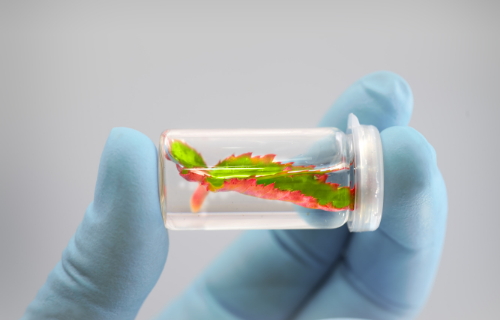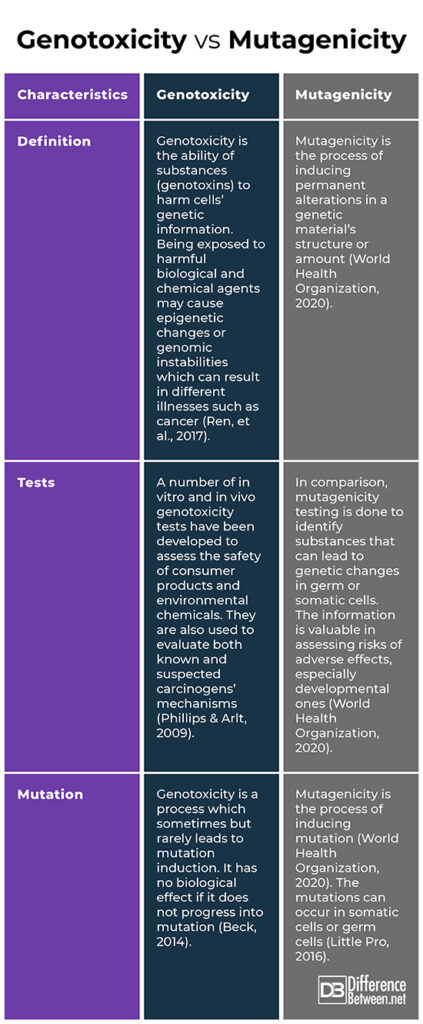Difference Between Genotoxicity and Mutagenicity
Both genotoxicity and mutagenicity involve changes in genetic material. Understandably, genotoxicity can be confused with mutagenicity since all mutagenic substances are genotoxic. However, not all genotoxic substances are mutagenic (Davey, 2020). The following discussions further delve into their differences.

What is Genotoxicity?
Genotoxicity is the ability of substances (genotoxins) to harm cells’ genetic information. Being exposed to harmful biological and chemical agents may cause epigenetic changes or genomic instabilities which can result in different illnesses such as cancer (Ren, et al., 2017). It is also defined as a set of modes of action that can cause adverse outcomes including ageing, developmental toxicity, and inherited diseases (Rawlinson, 2019). It can lead to direct or indirect effects like direct DNA damage which causes mutations and mistimed DNA event activation. Genotoxins can be categorized as carcinogens, mutagens, or teratogens (Davey, 2020). It is also important to note that genotoxicity is a process which sometimes but rarely leads to mutation induction. Genotoxicity has no biological effect if it does not progress into mutation (Beck, 2014).
A number of in vitro (outside the organism) and in vivo (in a whole, living organism) genotoxicity tests have been developed to assess the safety of consumer products and environmental chemicals. They are also used to evaluate both known and suspected carcinogens’ mechanisms (Phillips & Arlt, 2009). One famous example of the need for thorough genotoxicity testing is the historical case of thalidomide, a sedative drug which was prescribed to pregnant women to alleviate nausea, but it resulted in severe fetal abnormalities. This tragedy prompted more rigorous genotoxicity regulations specially for the pharmaceutical industry (Davey, 2020).

What is Mutagenicity?
Mutagenicity is the process of inducing permanent alterations in a genetic material’s structure or amount. A mutagen is genotoxin, it is a chemical, physical, or biological agent which induces genetic changes which can be inherited; it is usually through DNA interaction (World Health Organization, 2020; Samanthi, 2019).
Mutagenicity testing is done to identify substances that can lead to genetic changes in germ or somatic cells. The results are then employed in making regulatory decisions. The information is valuable in assessing risks of adverse effects, especially developmental ones (World Health Organization, 2020). Mutagenicity testing is helpful in assessing the effects of new drugs, food additives, pesticides, cosmetics, and other products (Sundar, et al., 2018).
The mutations can occur in somatic cells (body cells except reproductive germ cells) or germ cells (involved in the reproductive process and can generate a new organism; Little Pro, 2016):
- Somatic cells
Mutation in somatic cells can result in altered cell growth or cell death. Toxicity in somatic cells lead to different effects such as dermatitis, cancer, and death.
- Germ cells
The effects of mutations in germ cells are heritable. There is no effect on the exposed individual, but the effect is passed on to the next generations.
Difference between Genotoxicity and Mutagenicity
Definition
Genotoxicity is the ability of substances (genotoxins) to harm cells’ genetic information. Being exposed to harmful biological and chemical agents may cause epigenetic changes or genomic instabilities which can result in different illnesses such as cancer (Ren, et al., 2017). Mutagenicity is the process of inducing permanent alterations in a genetic material’s structure or amount (World Health Organization, 2020).
Tests
A number of in vitro (outside the organism) and in vivo (in a whole, living organism) genotoxicity tests have been developed to assess the safety of consumer products and environmental chemicals. They are also used to evaluate both known and suspected carcinogens’ mechanisms (Phillips & Arlt, 2009). In comparison, mutagenicity testing is done to identify substances that can lead to genetic changes in germ or somatic cells. The results are then employed in making regulatory decisions. The information is valuable in assessing risks of adverse effects, especially developmental ones (World Health Organization, 2020).
Mutation
Genotoxicity is a process which sometimes but rarely leads to mutation induction. It has no biological effect if it does not progress into mutation (Beck, 2014). On the other hand, mutagenicity is the process of inducing mutation (World Health Organization, 2020). The mutations can occur in somatic cells which are body cells except reproductive germ cells or germ cells which are involved in the reproductive process and can generate a new organism (Little Pro, 2016)
Genotoxicity vs Mutagenicity

Frequently Asked Questions:
Is genotoxicity the same as mutagenicity?
Understandably, genotoxicity can be confused with mutagenicity since all mutagenic substances are genotoxic. However, not all genotoxic substances are mutagenic (Davey, 2020). Genotoxic effects are not always related with mutations (Little Pro, 2016).
What is the difference between genotoxicity and carcinogenicity?
Genotoxicity is the ability of substances (genotoxins) to harm cells’ genetic information (Ren, et al., 2017). In comparison, carcinogenicity is specifically the ability to cause cancer (Kilcoyne, et al., 2013).
What is the difference between mutagenic and carcinogenic?
Mutagenic pertains to being capable of inducing genetic mutation. For instance, high energy radiations like X-rays are physical mutagenic agents. As for carcinogenic, it refers to being likely or able to cause cancer (Merriam-Webster, 2022). For instance, at least 70 chemicals in tobacco are carcinogenic (Booth, 2020).
What does mutagenicity mean?
Mutagenicity is the process of inducing permanent alterations in a genetic material’s structure or amount (World Health Organization, 2020).
Summary
- All mutagenic substances are genotoxic. However, not all genotoxic substances are mutagenic (Davey, 2020).
- Genotoxicity is the ability of substances (genotoxins) to harm cells’ genetic information (Ren, et al., 2017).
- Mutagenicity is the process of inducing permanent alterations in a genetic material’s structure or amount (World Health Organization, 2020).
- Genotoxicity and mutagenicity tests have been developed to assess the safety of consumer products.
- Difference Between Hematoma and Melanoma - February 9, 2023
- Difference Between Bruising and Necrosis - February 8, 2023
- Difference Between Brain Hematoma and Brain Hemorrhage - February 8, 2023
Search DifferenceBetween.net :
Leave a Response
References :
[0]Beck, N. (2014). Definitions of mutagenicity and genotoxicity. American Chemistry Council. C:/Users/Moi%20Gene/Downloads/CR6_8-1_BECK.PDF
[1]Phillips, D. & Arlt, V. (2009). Genotoxicity: Damage to DNA and its consequences. National Library of Medicine. https://pubmed.ncbi.nlm.nih.gov/19157059/
[2]Ren, N., Atyah, M., Chen, W., & Zhou, C. (2017). The various aspects of genetic and epigenetic toxicology: Testing methods and clinical applications. Journal of Translational Medicine. https://translational-medicine.biomedcentral.com/articles/10.1186/s12967-017-1218-4#:~:text=Genotoxicity%20refers%20to%20the%20ability,variety%20of%20diseases%2C%20cancer%20included.
[3]World Health Organization (2020). Genotoxicity. https://www.who.int/docs/default-source/food-safety/publications/section4-5-genotoxicity.pdf?sfvrsn=8ec3434_2
